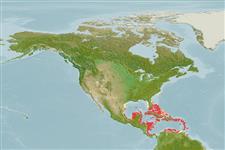>
Blenniiformes (Blennies) >
Tripterygiidae (Triplefin blennies) > Tripterygiinae
Etymology: Enneanectes: Greek, ennea = nine times + Greek, nektos = that swimms (Ref. 45335).
Environment: milieu / climate zone / depth range / distribution range
Ecologia
marinhas associadas(os) a recifes; intervalo de profundidade 0 - 11 m (Ref. 26938). Subtropical; - 9°N
Western Central Atlantic: southeastern Florida in USA, Bahamas and Yucatan in Mexico to Venezuela.
Tamanho / Peso / Idade
Maturity: Lm ? range ? - ? cm
Max length : 4.0 cm TL macho/indeterminado; (Ref. 7251)
Espinhos dorsais (total) : 10; Raios dorsais (total) : 7; Espinhos anais: 2; Raios anais : 15. This species is distinguished by the following characters: dark orbital cirrus, relatively broad, ending in a broad flat end or one to several shallow points; with 2-10 usually ctenoid scales on upper preopercle immediately behind eye, below sensory canal (in individuals over 1.8 cm SL); with a row of 4–9 intense dark, rounded spots along pored lateral-line, centered on dark body bars; the iris with six wide, red, spoke-like bands with much narrower interspaces (when live or fresh), spoke at 2 o’clock notably narrower than others; short snout with a broad dark band from orbit across front half of upper and lower jaws; the prominent dark bar curving from lower rim of orbit usually past corner of jaws and followed behind by a broad light bar, often with a central dark patch; dark dorsal head, preopercle and opercle; the rear body is bright red to red-orange, especially ventrally; anal fin is usually uniformly pigmented, but sometimes barred with reddish or dusky bands slanting forward from base; the caudal-peduncle dark bar is typically ovoid (wider at center with corners rounded) and usually narrower in width than height, ending at base of caudal-fin rays, followed on caudal fin by a narrow “accent” bar, red and/or dark, and then, after a narrow pale (white in life) band, a broad dark tail band often interrupted with a pale circle top and bottom (lower is larger), then a narrow pale (white in life) band at rear margin (Ref. 116142). Characters shared with Enneanectes quadra: D III+XII+7, with the first dorsal fin short, not reaching second-spine base of second dorsal fin (often barely reaching fin origin) when adpressed; A II,15; pectoral-fin rays 15; usually 13 pored lateral-line scales and about 19 or 20 scales in notched midline row; belly and pectoral-fin base scaled and with 2 scales above rear of pored lateral-line, upper scale much smaller [both characters of scaled-belly subgroup]; body bars 5 with last bar on caudal peduncle much darker; anterior orbital flange with fine spines (Ref. 116142).
Adults live in and about coral reefs and rocky shores in clear water. (Ref. 7251). Eggs are hemispherical and covered with numerous sticky threads that anchor them in the algae on the nesting sites (Ref. 240). Larvae are planktonic which occur primarily in shallow, nearshore waters (Ref. 94114).
Ciclo de vida ou comportamento de acasalamento
Maturities | Reprodução | Spawnings | Egg(s) | Fecundities | Larvas
Victor, B.C., 2017. The status of Enneanectes jordani and a new species of triplefin blenny from the Greater Caribbean (Teleostei: Tripterygiidae). J. Ocean Sci. Found. 27:48-73. (Ref. 116142)
Status na Lista Vermelha da UICN (Ref. 130435)
Ameaça para os humanos
Harmless
Uso pelos humanos
Pescarias: espécies comerciais; Aquário: Espécies comerciais
Ferramentas
Relatórios especiais
Baixar XML
Fontes da internet
Estimates based on models
Preferred temperature (Ref.
123201): 26.2 - 28.2, mean 27.4 °C (based on 528 cells).
Índice de diversidade filogenética (Ref.
82804): PD
50 = 0.5001 [Uniqueness, from 0.5 = low to 2.0 = high].
Bayesian length-weight: a=0.00562 (0.00258 - 0.01228), b=3.08 (2.89 - 3.27), in cm total length, based on LWR estimates for this (Sub)family-body shape (Ref.
93245).
Nível Trófico (Ref.
69278): 2.7 ±0.3 se; based on size and trophs of closest relatives
Resiliência (Ref.
120179): Elevada, tempo mínimo de duplicação da população menor que 15 meses (Preliminary K or Fecundity.).
Fishing Vulnerability (Ref.
59153): Low vulnerability (10 of 100).
Nutrients (Ref.
124155): Calcium = 313 [100, 1,376] mg/100g; Iron = 2.52 [0.83, 6.35] mg/100g; Protein = 18.9 [17.0, 20.8] %; Omega3 = 0.141 [0.028, 0.683] g/100g; Selenium = 29.7 [4.9, 151.4] μg/100g; VitaminA = 22.2 [2.1, 232.5] μg/100g; Zinc = 4 [2, 8] mg/100g (wet weight);
